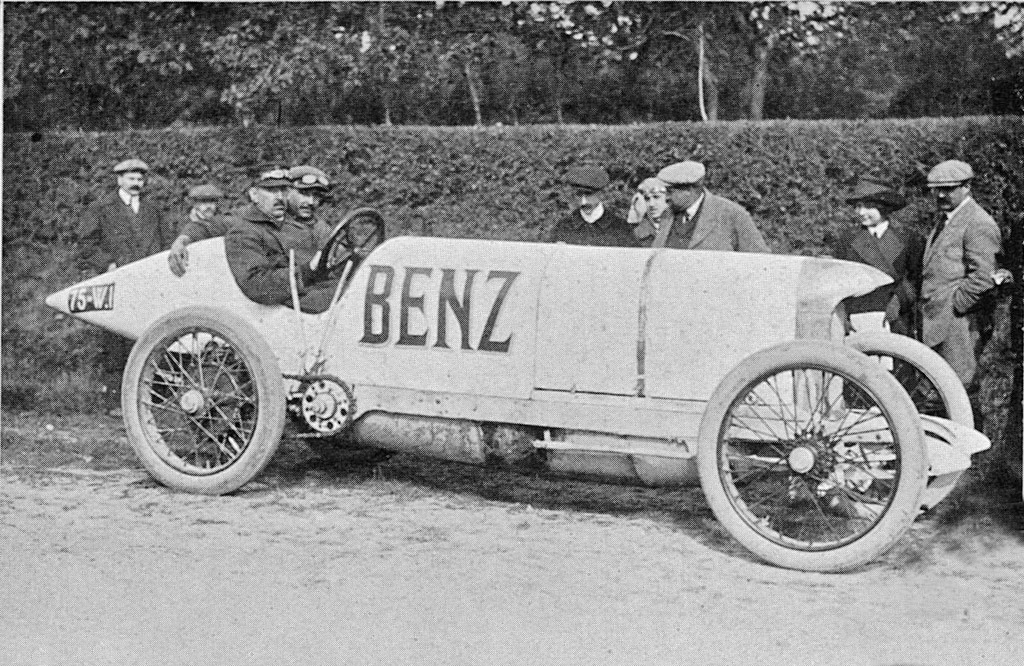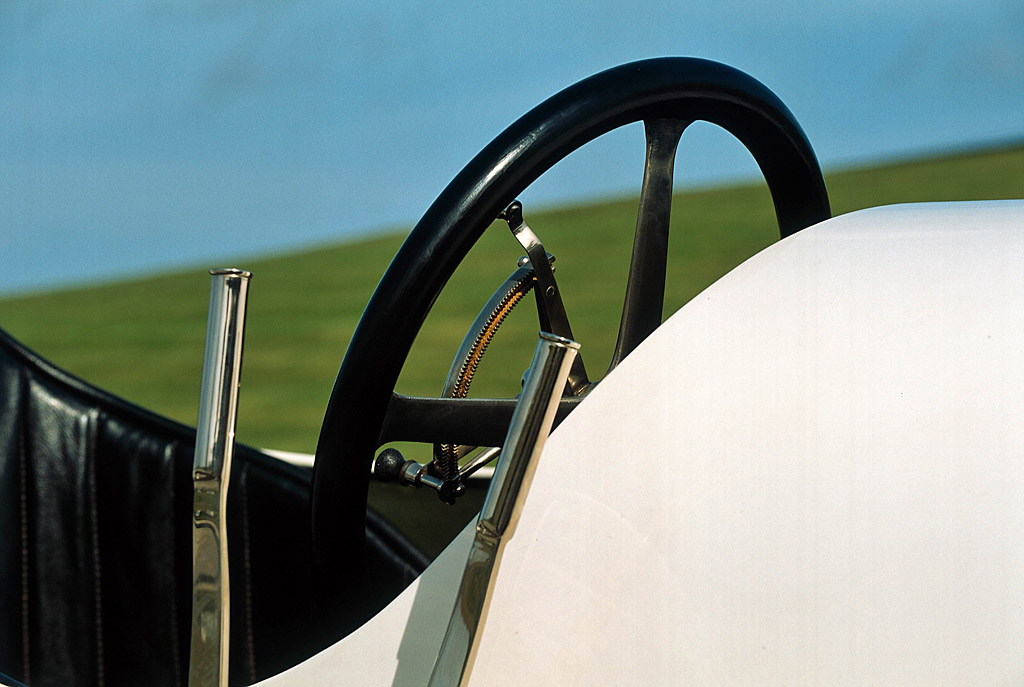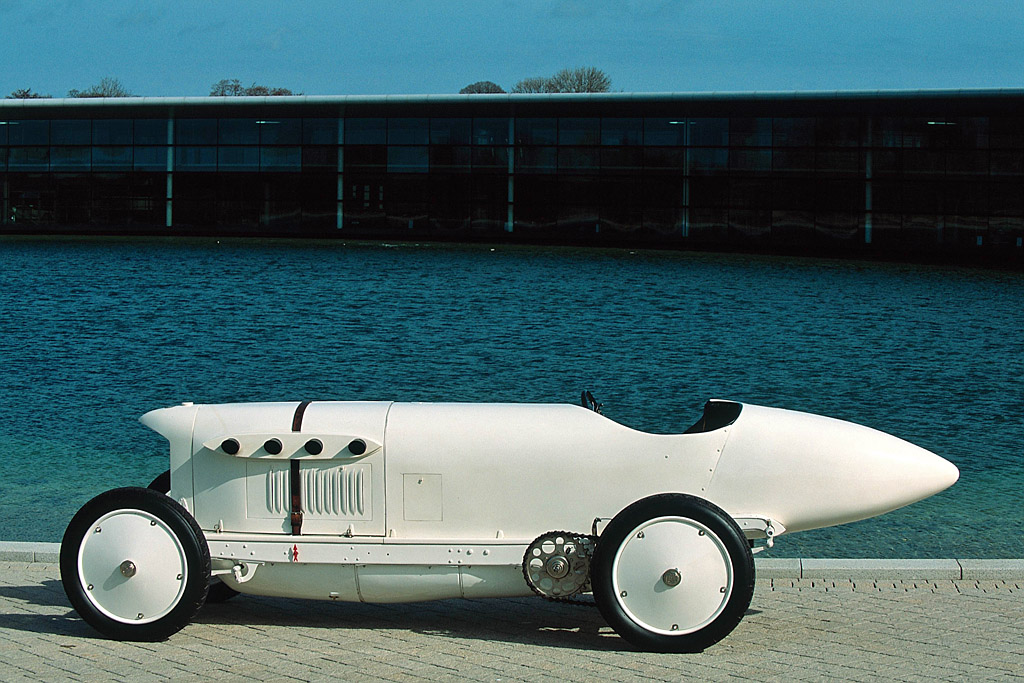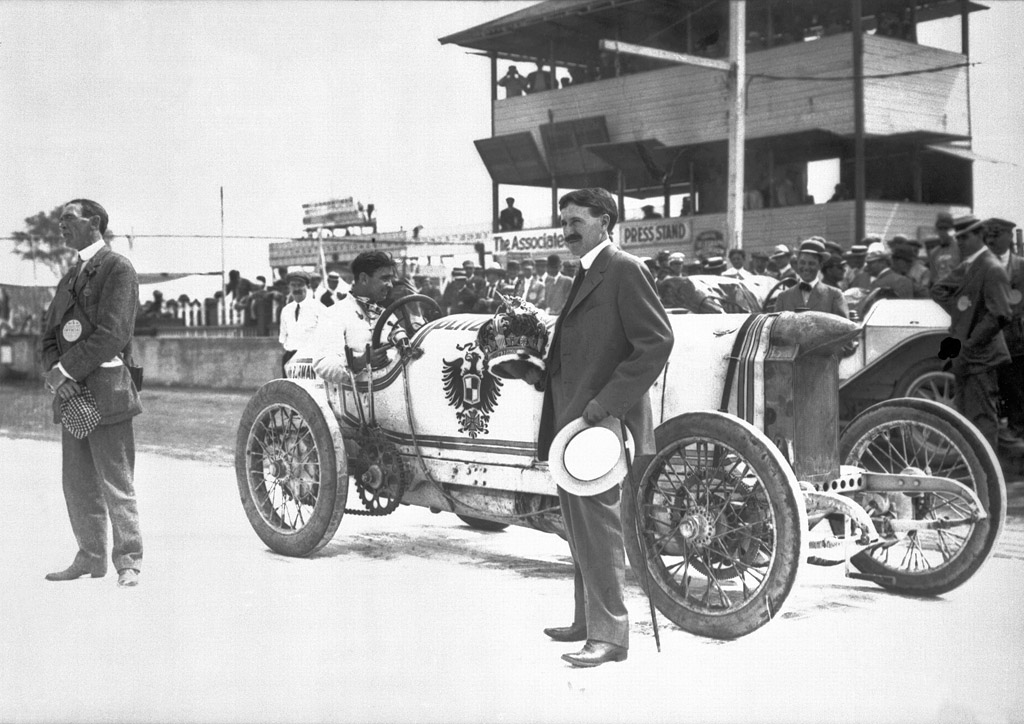1909 Benz 200HP Blitzen-Benz
At the beginning of 1909, Julius Ganss, working for Benz, was given permission to design a car which could reach a speed of over 200 km/h based on the 150 hp Benz Grand-Prix car. Providing the thrust to match the rhetoric was the 150-hp engine from the grand-prix racer, yet even this output fell short of what was required to fulfill such an ambitious brief. In the hour of need, the engineers fell back on a trusted method and bumped displacement up to 21.5 liters – setting a standard no other racing or record-chasing car produced by Benz & Cie. or Daimler Benz AG would ever reach again. The engine developed 184 hp at 1500 rpm in its original incarnation, before some technical trickery saw this figure rise to 200 hp at 1600 rpm. Weighing in at 407 kg, it was almost as imposing in its sheer physical size as in the power it produced.
Although the engine with serial number 5100 first saw action in the chassis and under the body of the Benz grand-prix car, it was known within the company as the 200-hp Benz, in line with the usual naming method. On August 22, 1909 Fritz Erle – a designer at Benz and later head of the testing and motor sport departments – stormed to victory in the one-kilometer race in Frankfurt/Main in double-quick time. Erle covered the kilometer with flying start in 22.6 seconds, equivalent to an average speed of 159.3 km/h and enough to earn him the Grand Duchess of Hesse prize.
The car had retained the body of the grand-prix model and entered events under this designation. Victor Hemery drove the 200-hp machine for the first time on October 17, totally outclassing the competition in a sprint race in Brussels. And the tarmac had barely had time to dry on the newly opened Brooklands circuit in England when the Benz works driver arrived on November 8, 1909 to set a new land-speed record. Héméry covered the one-kilometer distance from a flying start at an average speed of 202.7 km/h, breaking the all-important 200 km/h mark for the first time in Europe and proving that the car was capable of fulfilling its raison d’etre. This was, after all, a machine built to break records, and other new milestones were soon to follow. The kilometer from a standing start was completed in 31.326 seconds and the mile recorded in 41.268 seconds, equaling the mark set by Darracq.
Whilst the car was competing in these early races against rivals and clock, the engineers back in Mannheim were working feverishly to develop a new and aerodynamic body variant. The work was completed in late 1909 and the Benz finally took on a stylistic character very much of its own. Erle and Hemery made the car as narrow as possible in order to reduce wind resistance to a minimum, which explains why the gearshift and handbrake levers and the exhaust system were located outside the car body, with only bulges in the hood giving the exhaust rocker arms the space they required. The high-standing, narrow radiator core was accommodated behind a brass grille, whose upper end formed an expansion tank pointing out sharply from the front of the car. This ‘bird’s beak’ helped to give the record-breaking machine its striking and somewhat aggressive appearance, whilst at the rear of the car the body tapered off into a pointed tail. When it came to the seat positions, the driver and co-driver – whose job it was to operate the hand-operated gasoline pump – were literally shoulder-to-shoulder.
Eventually the first two 200HP Blitzen Benzs ended up and American and Buick works driver Bob Burman, lined up at Daytona Beach on April 23, 1911, this long, wide expanse of coastline providing the perfect venue for high-speed trials. Tapping the car’s full potential, he squeezed out an average 225.65 km/h for the mile with flying start and 228.1 km/h over the kilometer with flying start – a new land-speed record which was to remain unbroken until 1919. At the time, this made the Benz twice as fast as an aircraft, whilst the rail speed record (1903: 210 km/h) was also blasted out of sight.
1909 Benz 200HP Blitzen-Benz Gallery
See full 1909 Benz 200HP Blitzen-Benz Gallery here
In Detail
| engine | Bz 15524 Inline-4 |
| position | Front Longitudinal |
| aspiration | Natural |
| valvetrain | Single Lateral Camshaft, 2 Valves per Cyl |
| fuel feed | Horizonal Slide Carburetor |
| displacement | 21500 cc / 1312.0 in³ |
| bore | 185 mm / 7.28 in |
| stroke | 200 mm / 7.87 in |
| compression | 5.8:1 |
| power | 149.1 kw / 200 bhp @ 1600 rpm |
| specific output | 9.3 bhp per litre |
| bhp/weight | 137.93 bhp per tonne |
| body / frame | Steel over Pressed Steel Chassis |
| driven wheels | RWD w/Twin Chain Drive |
| wheel type | Wire-spoke or Wood-Spoke |
| front tires | 820 x 120 Continental Balloon |
| rear tires | 820 x 120 Continental Balloon |
| front brakes | None |
| f brake size | mm / in |
| rear brakes | External Band Acting on Driveshaft |
| r brake size | mm / in |
| f suspension | Rigid Axle w/Semi-Elliptic Leaf Springs |
| r suspension | Live Axle w/Semi-Elliptic Leaf Springs |
| curb weight | 1450 kg / 3197 lbs |
| wheelbase | 2800 mm / 110.2 in |
| front track | 1330 mm / 52.4 in |
| rear track | 1320 mm / 52.0 in |
| length | 4820 mm / 189.8 in |
| width | 1600 mm / 63.0 in |
| height | 1280 mm / 50.4 in |
| transmission | 4-Speed Manual |
| gear ratios | :1 |
| top speed | ~228 kph / 141.7 mph |














